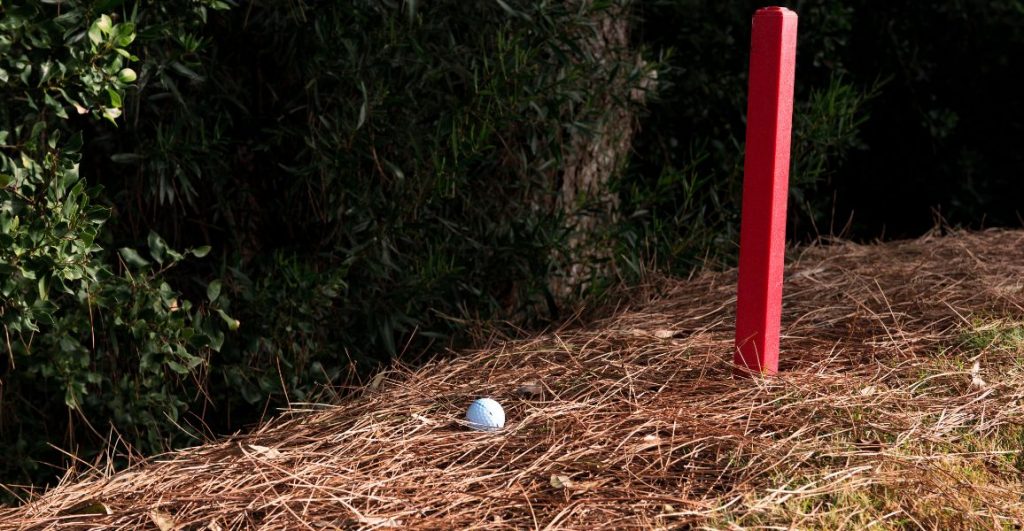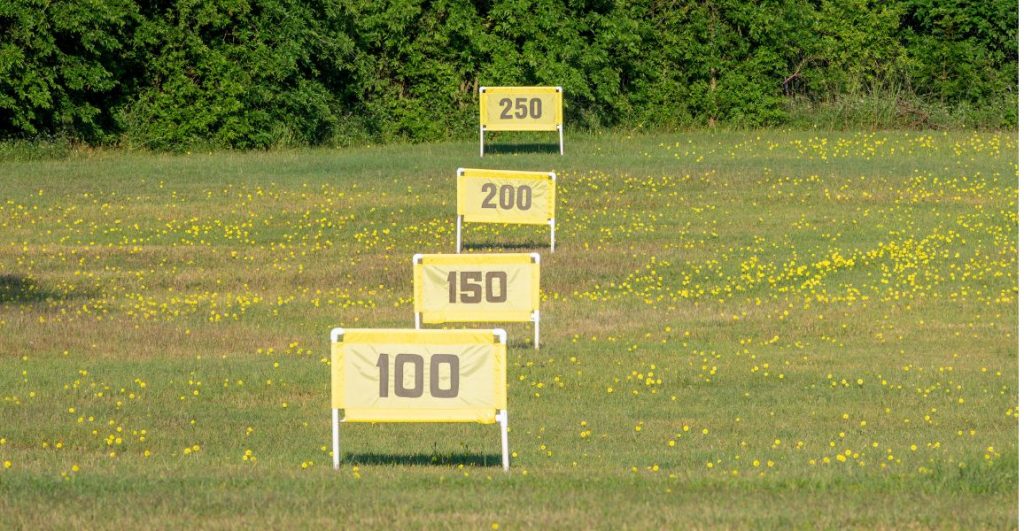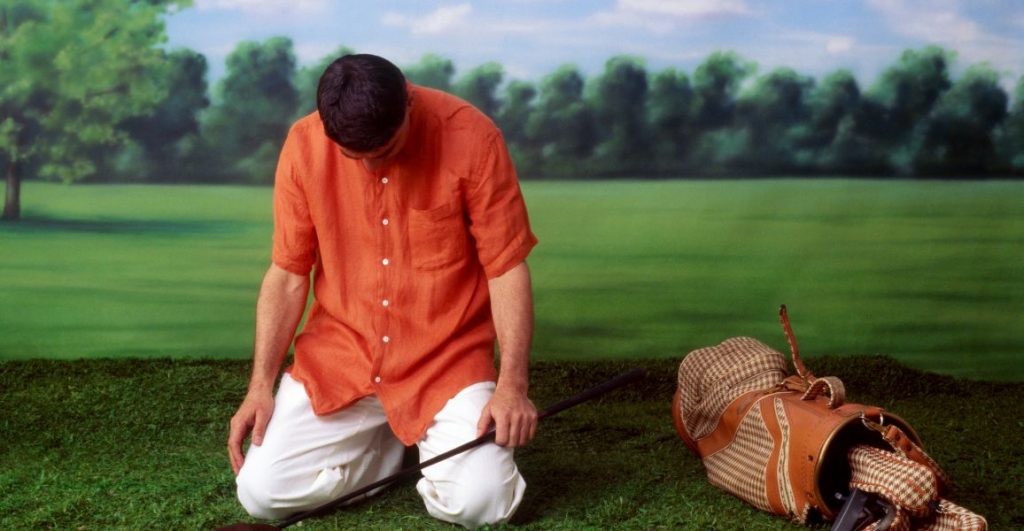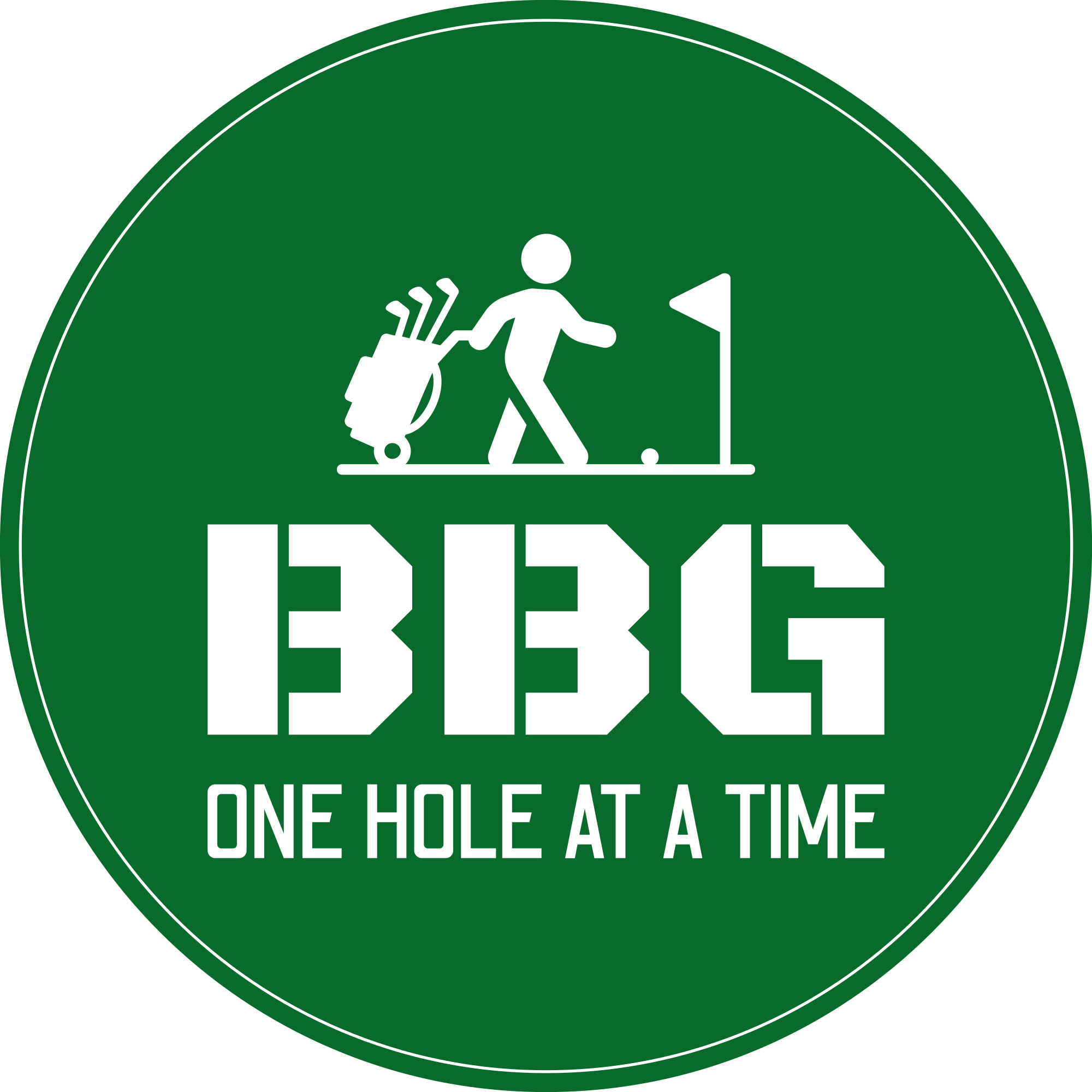Think about the last round of golf you played. If it wasn’t for all the bad tee shots caused by your slice, how much lower would you have shot?
You probably could knock 5,6,7, or 8 shots off your scorecard, improving your golf game hugely, depending on how bad your slice is.
You’re not alone, as it’s the most frustrating shot in all sports.
But after reading this post today, you will be one step closer to gaining some confidence on the tee box again, fixing your slice forever, and playing the golf you know you’re capable of.
In this post, you will find out what a slice is, why they’re so bad, a list of potential issues, and how to fix each one.
What Is A Slice?
Simply put, a slice is when your ball curves right of the target (right-handed golfers) or left of the target (left-handed golfers).
Some slices are more severe than others and shouldn’t be confused with hitting a fade. Fades are a shot where they curve minimally but still end up roughly where you’re aiming.
There are two kinds of slices:
The first is a push slice, this is when the ball starts out right of the target and continues to curve off to the right (right-handed golfers).
The second is a standard slice when the ball starts left of where you’re aiming but then curves off, ending up well right of your target (right-handed golfers).
In our opinion, standard push slices are trickier to fix as you have to fix both your golf swing direction (which is pushing the ball out right) and you have to fix the slice.
Double whammy!
Reasons Why Slices Are Terrible
You Can’t Aim Consistently:
Slices tend not to care where you’re aiming. They have one goal in mind: get to the opposite side of the fairway and as far away as possible.
Golfers with a slice try to work with their slice and aim further left (right-handed golfers) or right (left-handed golfers).
However, this very rarely works, and often, they make the slice worse by opening up their body to their target, or their ball goes dead straight where they aimed, which isn’t good either.
Aiming further out only works if you have a consistent fade or draw, but you can’t predict where a mishit will end up.
You Will Get Into Trouble:

A slice is usually not kind enough to stop on the fairway or in the second cut. No, they instead love drifting out into thick rough trees, long grass, water, or out of bounds.
The shot is guaranteed to land you in some trouble, which means your score is going to increase hugely.
When you’re hitting 3 off the tee box, scratching holes, or begging your friends for mulligans, it’s never going to result in a solid shooting.
You Will Lose Distance:

When you slice the ball, you lose a lot of distance. The reason for this is that the amount of spin you put on the ball means this shot is affected by the wind hugely.
That’s why whenever you hit into the wind, your slice becomes a mega slice, there’s too much spin.
Also, since the clubface is almost gliding across the golf ball instead of crashing into it directly, you won’t transfer as much force into it.
You Will Lose Confidence:

Less distance, bad accuracy, and lost golf balls all add up to a golfer who has had their confidence shaken out of them.
Not feeling confident on the tee box and then hitting bad shots will change your mood completely for the entire round, no matter how good the rest of your game is.
You then feel more pressure to hit other shots, and when none of it clicks together, you may feel like throwing your clubs in the trees, the lake, or just never playing again.
But it doesn’t have to be that way, and if you read the steps below, you should be able to patch up your slice for the next round.
Common Causes Of A Slice And How To Fix Them
Cutting Across The Ball (Over The Top)
Cutting across the ball or coming over the top is when the club head on your downswing cuts into your body.
Basically, if you were to draw a line from you for this club path, point A would be close to your lead foot, and point B would be in line with your trail foot but further from the body.
This can be caused by a few things like rushing your downswing, using your upper body too much, and so on, but you don’t need to worry about that.
All you need is the fix.
The Fix:
You have to reverse the club path so that point B of your trail foot is closer to your body and point A at the lead foot is further from the body.
A drill you can use to work on this is to get something like a headcover, driving range basket, foam block, or basically anything that isn’t made of glass.
Then, you need to place the object to the right (right-handed golfers) or left (left-handed golfers) of the golf ball by a few inches or so.
The only way to strike the golf ball now is to swing from in to out, if you tried to swing over the top, you would hit the object.
Start off slow and build up to speed, and if your club path is the problem, you should start seeing nice draws or straight bullets.
Should this not fix the problem, it could be an open clubface or something else.
Open Club Face Caused By A Weak Grip
Probably the most common cause of slices is an open clubface. An open clubface problem can drive a golfer mad as they try fixing problems in their swings that don’t exist.
You’re swing could be perfect, and the club path be on the money, but if the face is open, it will slice across the golf ball sending it spinning, off the golf course.
Although there are multiple things that can cause a clubface to remain open at impact, the usual culprit is a weak grip.
The Fix:
Look at your grip and how it sits on the club before you take your shot. Where is your back of your right hand (left hand for left-handed golfers)? Is it on top of the club or is it pointed more towards the side?
If it’s on top of the club, you have a grip that favors an open clubface as the hands will twist at high speeds, causing a slice.
You’re much more likely to have a closed face on impact if you’re bottom hand is more to the side of the grip or club.
Just slide your hand so it feels it’s moving to the underside of the club and take a few swings.
Ball Position Is Off
Having your golf ball too far forward or backward can cause you to slice the golf ball if not catch it thin or pop it up into the sky.
Your driver is the longest club in your bag, so while having the ball central in the stance works for other clubs, it will just cause problems with the driver.
When the ball is too close to center, you can’t hit the golf ball on the upswing, which is needed for proper contact and maximum distance.
However, having the ball too far forward in your stance means you have to stretch to hit the ball, which promotes an over-the-top motion.
Too far back? Too far forward? How can you make sure you have the right ball position?
The Fix:
A simple fix for this problem is to make sure the golf ball is in line with the inside of your lead foot (the side your big toe is on).
You only need an alignment stick or a golf club to drill this. You need to place the stick or club on the ground, pointing from the ball towards your stance.
Ensure the stick is parallel to your target, and then get into your golfing stance. Set up your stance so the stick is aligned with the inside of your foot and the golf ball.
Make sure to leave a little space between your ball and stick so you don’t hit it by mistake.
Foot Position Is Off
There is more to foot position than have far they are space apart or if they are in line with the ball.
Often, golfers don’t understand that the angle your foot is pointing can make a difference to your swing.
If you suffer from a slice, you should look out for if your lead foot is pointing straight forward or if it’s angled towards the target.
When your foot is angled towards the target slightly, is can increase the likelihood of a slice for the majority of golfers.
So what’s the fix?
The Fix:
To fix a slice or encourage a draw can be as simple as making sure your front foot points forward parallel to the target.
Then if you need some extra help in fixing your slice or hitting a draw, open your trail foot away from the target. This will help your hips clear and promote a more in-to-out swing plane needed for a draw.
Poor Posture
Bad posture when you’re setting up with the driver would be knees that are too flexed and an upper body that is too upright.
When a golfer is too upright, it means that during the downswing, they will likely swing over the top and slice across the ball.
This happens because there isn’t enough space between the arms and the body. You need space here for the arms to be able to swing from in to out by keeping close to the body as it rotates.
The fix is pretty simple.
The Fix:
All you have to do is flex your knees slightly and hinge forward at the hips towards the golf ball. You may feel awkward at first, but over time, this will become comfortable.
Now you should have no problem swinging from in-to-out and stop coming over the top.
Swinging Too Hard
Every golfer wants to hit the driver like the professionals, and they believe you have to swing like a pro baseball player to accomplish this goal.
While speed is necessary for big bombs, just gripping a ripping using your arms without all the other body parts firing will cause big slices.
Most golfers rush their backswing, start their downswing too fast, and end up coming over the top.
So what’s the fix?
The Fix:
Without trying to come across as a wise guy, you just need to stop swinging so fast and slow everything down, at least for now.
Get used to swinging slowly and hitting shots. You might lose some distance, but you won’t lose as many golf balls.
A drill you can try at the driving range is to start swinging as slowly as possible and focus on hitting the ball straight, even if it’s just 50 yards in front of you.
Hit a few golf balls like this, then swing a little faster and go for 100 yards, and so on, until you’re back up to full speed.
If you can’t hit the ball straight to 150 yards, then don’t move past this point until you can get it.
Arms Getting Away From Your Body
When you’re making a driver swing for more consistent results, your arms should stay close to the body as much as possible, especially on the downswing or follow-through.
Not only do you lose out on distance as your arms drift from your body, but also accuracy and control of the clubface.
When you get too far out, the likelihood of swinging over the top of the hand/arms getting ahead of the golf club, which opens the face, increases.
“Well, go ahead and tell us the fix?” No problem at all!
The Fix:
To work on keeping your arms from getting too wild on you, all that is needed is a towel or even a headcover.
We want to work on keeping our trail arm, which is right for right-handed golfers and the opposite for lefties, close to our bodies as we turn through.
This can be accomplished by placing the towel or small headcover under your right armpit (left armpit for left-handers), and all you do is try to swing as normally as possible without the towel falling.
If it keeps coming loose, it means your arms have separated from your body. Drill this at the range, and over time, you engrain the feel needed to hit nice big draws instead of slices.
You’re Teeing The Ball Down Too Low
Yes, that’s right you’re ugly slice could be caused by something as simple as teeing the ball down too low.
But how does this cause a slice? Well ideally when using a driver you want an upward attack angle which is nearly impossible when the ball is low to the ground.
Most golfers who tee the ball low actually have a downward attack angle at the ball which adds a bunch of spin.
This paired with you cutting across the ball can only mean one thing, a mega slice that refuses to stop for at least 2 fairways over.
So what’s the fix?
The Fix:
The only fix for this issue is to tee the ball up higher, the higher you go the more you’ll have to swing up at the ball to make good contact.
For myself, the sweet spot and many other golfers is to tee it up until half the ball it above the club head.
But I would always recommend you go to the driving range and experiment with different tee heights to figure out which one you get the most consistent results from.
Once you feel confident you found the optimal tee height for you don’t stray from it. Keep working at it.
Something that was suggested to me when I was starting out was to buy the same brand/type of tees all the time.
By doing this you can pick a marker on the tee, maybe it’s a logo or a letter if you’re using a traditional style tee.
Liked this post? Then you’ll love the below posts too:
7 Best Drivers For Golfers On The Market Today
How Far To Stand From The Golf Ball
How To Stop Hooking Your Driver
Average Distances For Each Golf Club
